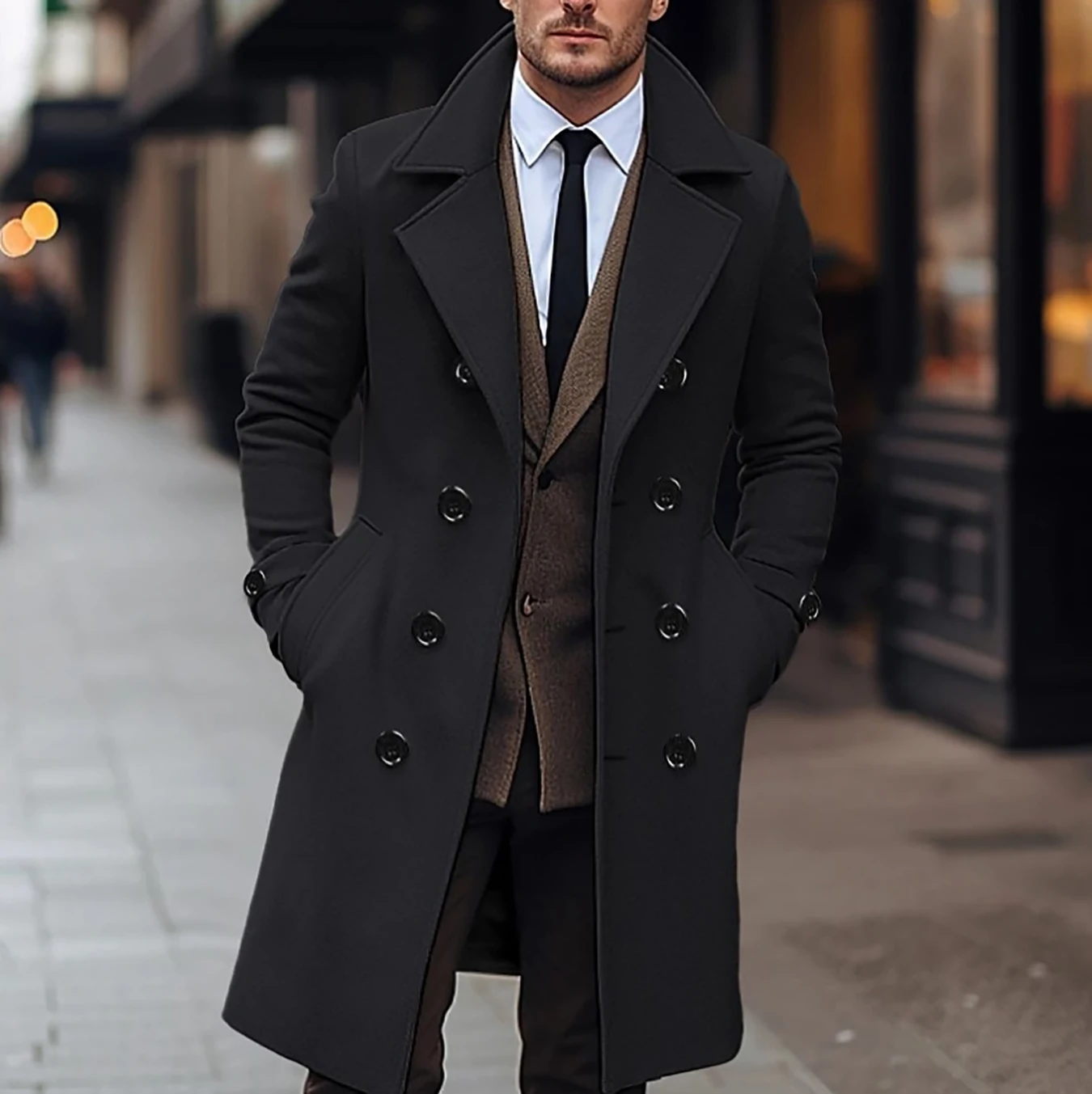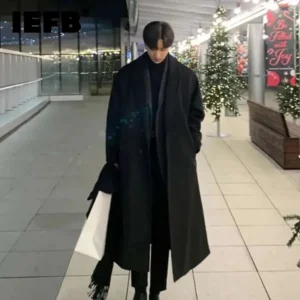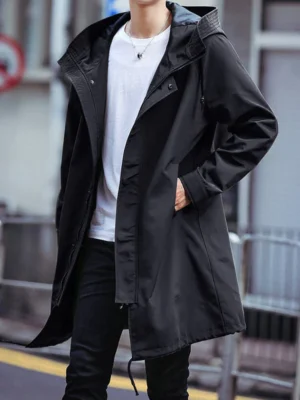Introduction: The Quintessence of the Formal Men’s Overcoat
A formal overcoat represents the perfect marriage of necessity and elegance in men’s fashion. More than mere protection from the elements, these distinguished garments serve as the finishing touch to formal attire, enhancing a man’s silhouette while maintaining warmth and comfort. Unlike their casual counterparts, formal overcoats are defined by refined silhouettes, premium materials, and meticulous construction that speaks to their heritage as investment pieces.
The true value of a quality overcoat extends beyond momentary fashion trends. These garments have maintained their position as symbols of refinement throughout decades of changing styles. When crafted properly, a formal overcoat features canvas interlining, hand-finished details, and premium wool or cashmere that ensures both warmth and drape. This combination of practical function and distinguished appearance makes the formal overcoat an essential cornerstone in any gentleman’s wardrobe.
Understanding choosing right coat length becomes crucial when investing in such a significant wardrobe piece. The perfect formal overcoat strikes a balance between coverage, proportion, and style that complements rather than overwhelms the wearer.
In this guide, we’ll explore the classic styles that define formal men’s overcoats, essential considerations when selecting one, proper styling approaches, and key factors to evaluate when making this significant investment. Whether for business settings or evening formal events, the right overcoat makes a powerful statement about your attention to detail and appreciation for timeless style.
Pillars of Formal Men’s Outerwear: Classic Overcoat Styles
The Chesterfield Coat: Timeless Refinement
The Chesterfield stands as perhaps the most versatile and enduring formal overcoat style. Originating in the 1840s and named after the Earl of Chesterfield, this coat has evolved from its aristocratic roots to become a staple in professional wardrobes worldwide.
Defining characteristics include:
– Single-breasted front, typically with concealed buttons or fly front
– Structured shoulders with minimal padding
– Optional velvet collar (though modern versions often feature matching fabric)
– Clean lines with no waist suppression
– Knee-length or slightly longer, typically 40-45 inches (101-114 cm)
– Center back vent for ease of movement
The Chesterfield occupies a sweet spot in the formality spectrum, appropriate for professional environments, evening events, and nearly any occasion requiring refined outerwear. Its classic silhouette complements both suits and formal evening wear.
Traditional Chesterfields feature heavyweight wool in charcoal, navy, or black, though contemporary versions may incorporate cashmere blends for added luxury. Understanding men’s coat length guide principles helps ensure you select a Chesterfield that properly frames your formal attire.
The Paletot Coat: Distinguished Sophistication
With French origins and British refinement, the Paletot represents formal outerwear at its most distinguished. This double-breasted masterpiece creates a commanding presence through its structured silhouette.
Key elements include:
– Double-breasted front with six buttons in a 6×2 configuration (six buttons with only two functioning)
– Peaked lapels that create a strong shoulder line
– Straight, clean cut with minimal tapering
– No back belt detail or pleats
– Semi-fitted silhouette that accommodates layers
– Traditional knee-length cut
The Paletot’s inherent formality makes it ideal for business settings, formal evening events, and occasions where a refined impression is essential. Its structure provides excellent insulation while creating a commanding profile.
Most commonly crafted from heavyweight wool in navy or charcoal, the Paletot can also be found in black for maximum formality. For those appreciating this style, exploring our men’s double-breasted overcoat collection provides excellent options to complement formal attire.
The Ulster Coat: Robust Elegance
Originally designed for harsh Irish weather, the Ulster coat has evolved from country wear to become appropriate for formal urban settings when properly executed. This substantial overcoat offers unparalleled protection while maintaining a dignified appearance.
Distinctive features include:
– Double-breasted front, often with 6×2 or 8×4 button arrangement
– Ulster collar (a notched lapel that can be buttoned up to the neck)
– Generous cut for layering over suits
– Half-belt or martingale strap across the back
– Turn-back cuffs and patch pockets
– Length typically extending below the knee
While traditionally less formal than the Chesterfield or Paletot, a well-tailored Ulster in appropriate materials bridges the gap between rugged functionality and refined appearance. Modern interpretations in fine wool make this coat suitable for professional settings and formal occasions in colder climates.
Though historically crafted from heavy tweed, contemporary formal Ulsters often feature herringbone or plain wool in navy, charcoal, or other subdued colors appropriate for professional environments.
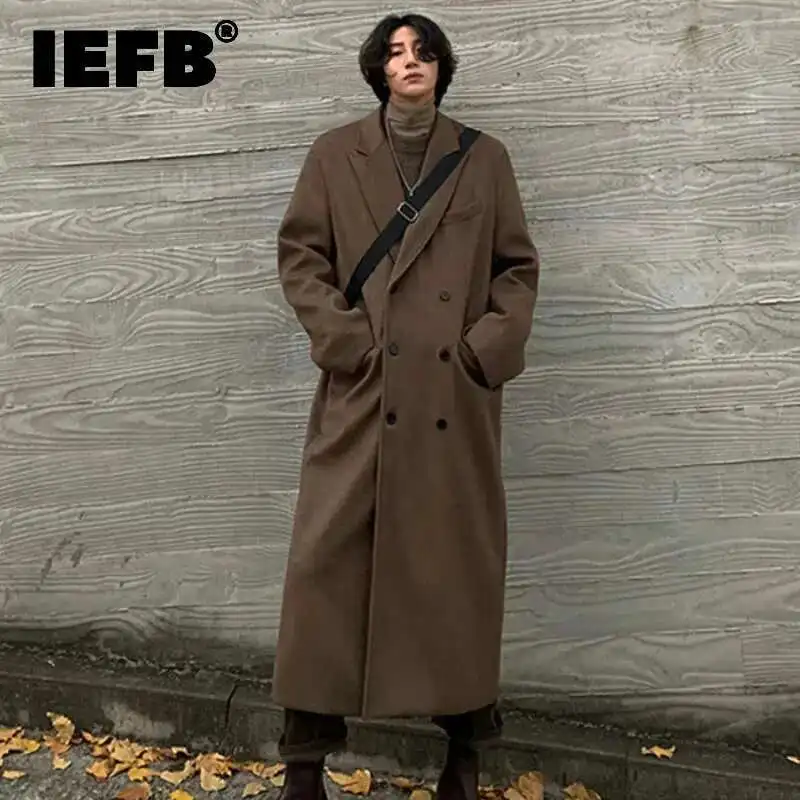
The Covert Coat: Refined Versatility
The Covert coat occupies a unique position in formal men’s outerwear, originating in hunting traditions but evolving into a respected city coat. This shorter option provides flexibility across various dress codes.
Signature elements include:
– Single-breasted front with concealed placket
– Notched lapels of moderate width
– Four distinctive rows of stitching at cuffs and hem (known as “railroading”)
– Ticket pocket above the right side pocket
– Fly front with concealed buttons
– Length typically at or slightly above the knee
While not appropriate for the most formal evening events, the Covert coat pairs beautifully with business attire and can transition to smart-casual settings. Its structured shoulder and clean lines maintain formality while its hunting heritage adds subtle character.
Traditionally crafted from covert cloth (a tightly woven twill) in fawn or olive-brown, modern interpretations expand to include navy and charcoal for increased formality. For a distinctive pattern option, our men’s herringbone coat collection offers excellent formal choices with added visual texture.
Essential Considerations When Choosing a Formal Overcoat
Materials: Quality That Warms and Impresses
The fabric of a formal overcoat determines not only its appearance but also its performance, comfort, and longevity. Premium materials justify their cost through superior warmth, drape, and resilience.
Wool Varieties:
– Melton: Dense, smooth wool with exceptional insulation and wind resistance, ideal for severe winter conditions
– Cashmere: Luxuriously soft, lightweight yet incredibly warm; often blended with wool for durability
– Alpaca: Exceptionally insulating with natural water resistance and silky texture
– Vicuña: The rarest and most expensive wool, prized for its incomparable softness and lightweight warmth
Proper formal overcoats typically feature fabric weights between 20-30 ounces per yard (570-850 grams) for winter wear, with cashmere options sometimes lighter while maintaining warmth. Higher thread counts and longer wool fibers generally indicate superior quality and comfort.
Lining materials also significantly impact both comfort and longevity. Silk or viscose provide smooth entry and exit, while premium overcoats may feature quilted linings for additional insulation without bulk. Our men’s wool overcoat collection showcases premium materials selected for their perfect balance of warmth, appearance, and durability.
Color Selection: Classic Tones for Maximum Versatility
While formal overcoats permit some personal expression, certain colors have earned their status as classics by providing maximum versatility and appropriateness across formal contexts.
Standard Formal Overcoat Colors:
– Navy: Perhaps the most versatile option, complementing nearly any suit color
– Charcoal grey: Provides elegant contrast with lighter suits while coordinating with darker ones
– Black: Maximum formality, especially for evening events
– Camel: A distinctive yet classic choice that pairs beautifully with navy and grey suits
When selecting a color, consider both your existing wardrobe and the contexts where you’ll wear the coat. Navy and charcoal offer the greatest flexibility, while black provides unmatched formality for evening functions. For those seeking this maximum formality, our men’s black overcoat collection offers impeccable options.
In formal contexts, patterns should remain subtle. Herringbone and faint pinstripes maintain formality while adding visual interest, but bold patterns or colors risk undermining the coat’s refined purpose.
Fit: The Art of the Proper Silhouette
A formal overcoat must accommodate layers without appearing oversized or sacrificing its structured silhouette. This delicate balance requires attention to several key areas.
Critical Fit Considerations:
– Shoulders: Should extend approximately 1/2 inch (1.25 cm) beyond your suit jacket shoulders
– Chest: Allow 1-2 inches (2.5-5 cm) of room beyond your suit jacket measurement
– Sleeve length: Should cover suit sleeves completely while allowing 1/4-1/2 inch (0.6-1.25 cm) of shirt cuff to show
– Body: Clean lines without pulling when buttoned over a suit
– Length: Typically extending to just below the knee for maximum formality and coverage
When trying on a formal overcoat, always wear a suit or at least a suit jacket to ensure proper fit over your formal attire. The coat should close comfortably without strain while maintaining its tailored appearance. Understanding the perfect coat length for height relationship helps ensure proportionate appearance appropriate to your frame.
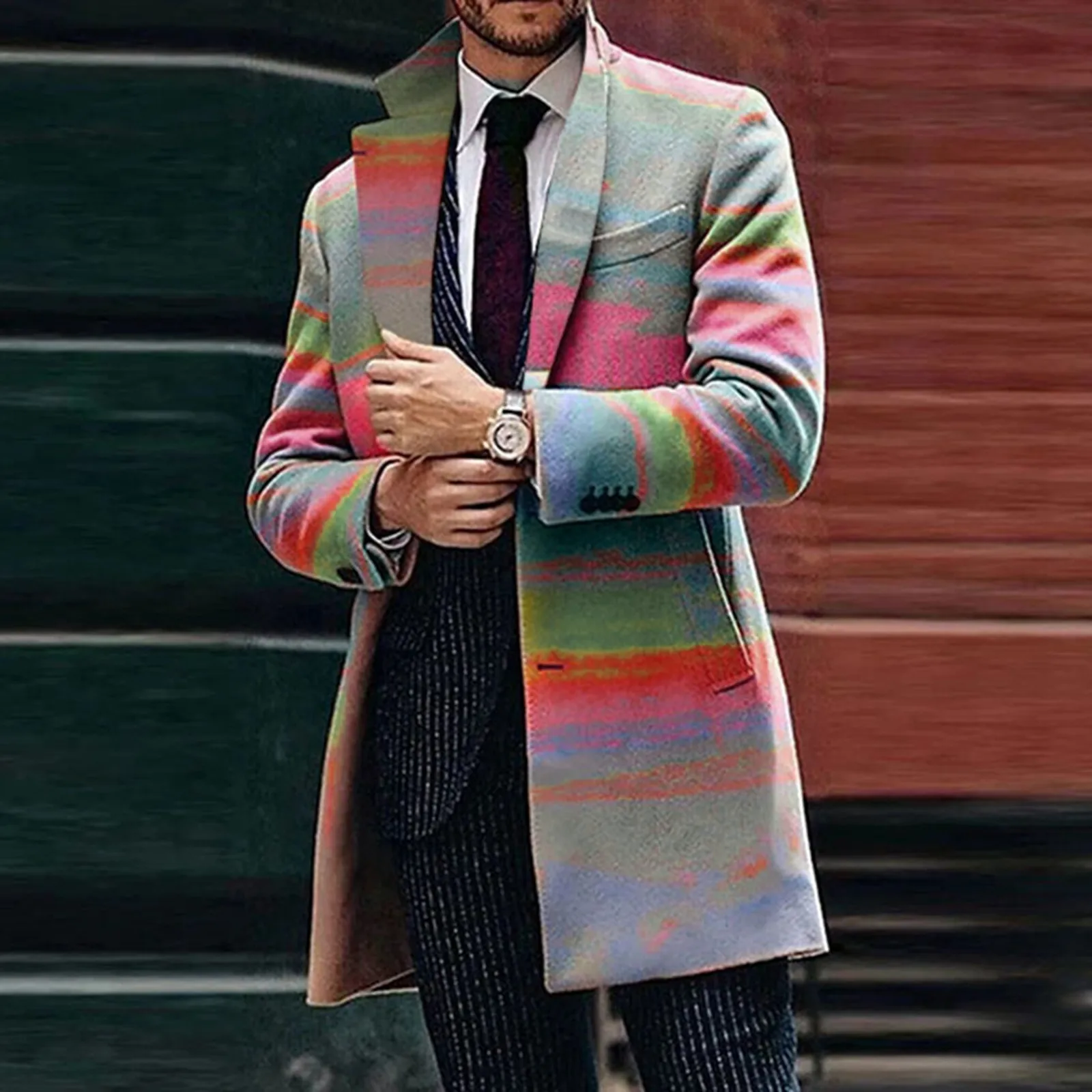
Construction: Single-Breasted vs. Double-Breasted
The choice between single and double-breasted construction significantly impacts both the overcoat’s appearance and practical considerations.
Single-Breasted Advantages:
– Greater versatility across formality levels
– Easier to wear open when desired
– Typically lighter weight
– Flattering for most body types
– More contemporary appearance
Double-Breasted Advantages:
– More formal and dramatic presence
– Superior cold weather protection with overlapping front
– Creates a stronger shoulder line
– Distinctive military-inspired heritage
– Makes a more substantial style statement
Body type influences this choice significantly – double-breasted styles add visual bulk and can overwhelm smaller frames, while single-breasted options provide a cleaner line for all builds. For navigating these considerations, our guide on short vs long coats guide offers valuable insights on selecting the most flattering proportions.
Styling Guide: Masterfully Coordinating the Formal Overcoat
Over a Business Suit: The Classic Professional Ensemble
The most common formal overcoat pairing remains with a business suit, where the coat serves as both protection and enhancement of professional appearance.
Key Business Styling Principles:
– Ensure the overcoat is longer than your suit jacket, typically by 5-6 inches (13-15 cm)
– Navy and charcoal overcoats offer maximum versatility across suit colors
– Lighter overcoat colors (like camel) create striking contrast with dark suits
– Collar can be worn up in inclement weather without sacrificing formality
– Allow suit jacket sleeves to remain completely covered
Accessories should maintain formal coherence – leather gloves, a cashmere scarf in complementary or contrasting colors, and a structured umbrella complete the professional appearance. The men’s coat length style guide provides additional insights on creating visually balanced ensembles.
With Evening Formal Wear: Elegance for Black Tie and Beyond
For black tie and formal evening events, the overcoat must match the elevated formality of what lies beneath.
Evening Formal Wear Guidelines:
– Black or midnight navy overcoats provide the most appropriate formality
– Chesterfield and Paletot styles are traditionally preferred for black tie
– Velvet-collared Chesterfields offer a distinguished evening option
– White silk scarves provide traditional contrast against dark overcoats
– Clean lines without casual details maintain formal coherence
While a perfectly tailored black Chesterfield represents the height of evening formality, the modern gentleman can also consider midnight navy or charcoal options depending on the formal attire beneath. For exceptional evening options, explore our men’s dress coat collection designed specifically for formal occasions.
Essential Accessories: Completing the Formal Look
Accessories elevate a formal overcoat from mere practicality to complete refinement.
Formal Overcoat Accessories:
– Scarves: Cashmere or silk in solid colors or subtle patterns; white silk for maximum formality
– Gloves: Leather in black, brown, or navy depending on coat color; cashmere-lined for added warmth
– Hats: Classic fedora, homburg, or trilby in coordinating colors
– Umbrellas: Solid construction with wooden handles for traditional elegance
Each accessory should complement rather than compete with the overcoat’s inherent elegance. For cold weather, scarves should be neatly draped rather than casually wrapped to maintain formality. When selecting these finishing touches, choosing perfect dress coat formal considerations can help ensure a coherent ensemble.
Investing in a Classic: Purchase Considerations
Recognizing Quality: Construction and Material Markers
A quality formal overcoat represents a significant investment, with construction details often separating exceptional garments from average ones.
Quality Indicators:
– Canvas interlining rather than fused construction
– Hand-finished buttonholes and button attachment
– Clean, consistent stitching (10-12 stitches per inch or 4-5 per cm)
– Pattern matching at seams, particularly visible on patterned fabrics
– Full lining with interior pockets
– Reinforced pocket openings
– Natural shoulder line without excessive padding
Examine materials by touch – premium wool should feel smooth yet substantial, with a clear resilience when gently compressed. Superior fabrics return to shape quickly when crushed in your hand, indicating quality fiber content and proper construction.
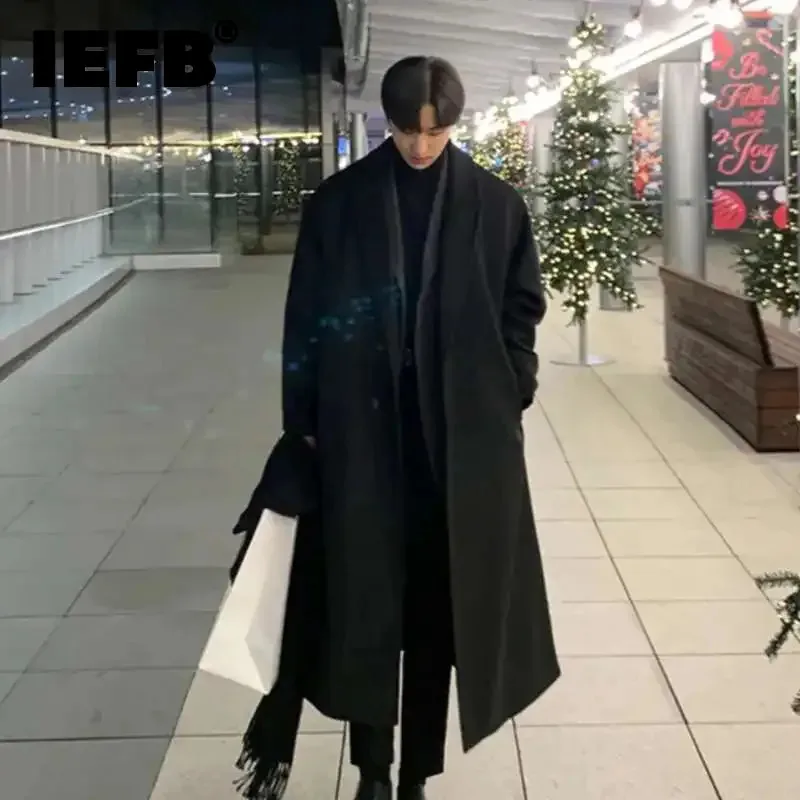
Longevity: The Overcoat as a Long-Term Companion
With proper care, a quality formal overcoat easily lasts 10+ years of regular seasonal wear, making it a true wardrobe investment.
Care Essentials:
– Professional dry cleaning only, typically once per season
– Brushing with a clothes brush after each wearing
– Allowing 24 hours rest between wearings
– Proper hanging on shaped wooden hangers
– Off-season storage in breathable garment bags with cedar elements
– Addressing minor damage immediately before it worsens
These practices maintain both appearance and structural integrity, preserving your investment. For exceptional quality and longevity, our men’s cashmere overcoat collection represents the pinnacle of formal outerwear designed for decades of service.
Mens Cashmere Overcoat, Mens Hooded Winter Coat, Mens Wool Blend Coat
Price range: $128.72 through $139.68 Select options This product has multiple variants. The options may be chosen on the product pageMens Black Overcoat, Mens Black Wool Coat, Mens Wool Overcoat
$339.18 Select options This product has multiple variants. The options may be chosen on the product pageMens Grey Overcoat, Mens Wool Blend Coat, Mens Wool Overcoat
$201.28 Select options This product has multiple variants. The options may be chosen on the product pageMens Herringbone Coat, Mens Long Overcoat, Mens Wool Overcoat
Price range: $197.16 through $203.69 Select options This product has multiple variants. The options may be chosen on the product pageMens Black Overcoat, Mens Long Overcoat
Price range: $100.12 through $173.24 Select options This product has multiple variants. The options may be chosen on the product pageMens Dress Coat, Mens Long Overcoat
$76.76 Select options This product has multiple variants. The options may be chosen on the product page
Value Proposition: When Higher Investment Makes Sense
Formal overcoats demonstrate a clear relationship between price and quality, though with important nuances regarding value.
Quality formal overcoats typically occupy several price tiers:
– Entry-level quality ($500-800): Good materials with primarily machine construction
– Mid-range quality ($800-1,500): Superior materials with some hand-finishing
– Premium quality ($1,500-3,000): Exceptional materials with significant hand-crafting
– Luxury tier ($3,000+): Finest available materials with predominantly handmade construction
The sweet spot for many represents the mid to premium range, where significant quality improvements justify increased investment without reaching the sometimes diminishing returns of the highest luxury tier. When evaluating price against quality, consider cost-per-wear over the garment’s expected lifespan rather than just the initial investment.
Procurement Options: Where to Find Quality Overcoats
Quality formal overcoats can be acquired through several channels, each with distinct advantages.
Acquisition Options:
– Specialized menswear retailers: Expert guidance and curated selection
– Department stores: Broader selection across price points
– Made-to-measure services: Customized fit with material selection
– Online specialty retailers: Wider selection and often competitive pricing
– Heritage brands: Established reputation for quality and consistency
– Seasonal sales: Opportunity for significant value on premium pieces
When purchasing online, pay special attention to detailed size guides and material descriptions. Look for retailers who provide comprehensive measurements rather than simply “small/medium/large” sizing to ensure proper fit. Whenever possible, familiarize yourself with a brand’s sizing in person before making substantial online purchases.
Frequently Asked Questions
What is the ideal length for a formal overcoat?
The most universally appropriate formal overcoat length extends to just below the knee, typically 40-45 inches (101-114 cm) depending on the wearer’s height. This length provides proper coverage for suits and formal wear while maintaining balanced proportions. However, height should influence this decision – taller men can wear slightly longer coats while shorter men may prefer lengths hitting just at the knee to avoid overwhelming their frame. For complete guidance, our definitive guide full coat length provides comprehensive information for selecting the perfect length.
Which color is most versatile for a formal overcoat?
Navy blue represents the most versatile formal overcoat color, complementing virtually all suit colors including navy, grey, black, and brown. It maintains appropriate formality for evening events while transitioning seamlessly to daytime business wear. Navy also shows less dust and minor soiling than black, making it slightly more practical for everyday wear while remaining undeniably sophisticated.
Can I wear a formal overcoat in casual settings?
While formal overcoats are designed primarily for business and formal attire, they can be tastefully styled in more casual contexts. Pairing a formal overcoat with dark jeans, a fine gauge sweater, and leather boots creates a sophisticated casual look that leverages the coat’s refinement without seeming overdressed. The Chesterfield and Covert styles adapt most readily to casual settings, while double-breasted Paletot coats generally remain too formal for casual wear.
How should I properly care for and store my wool overcoat?
Proper maintenance begins with routine care – brushing after each wearing with a clothes brush to remove surface particles and allowing the garment to rest between wearings. Professional dry cleaning should be limited to once per season or when specifically needed to avoid degrading the wool fibers. During off-season storage, use breathable garment bags rather than plastic, incorporate cedar elements to deter moths, and store in a cool, dry place away from direct sunlight. These practices preserve both the appearance and structural integrity of fine wool overcoats.
Supplementary Content: Historical Context of Formal Overcoats
From Military Origins to Civilian Elegance
Many formal overcoat styles trace their lineage to military uniforms, where function eventually evolved into distinguished civilian fashion. The Chesterfield emerged as civilian adaptation of military greatcoats, while the Ulster’s protective design served mounted officers before becoming a civilian staple. This military heritage explains the structured shoulder, commanding presence, and protective elements that define formal outerwear today.
British aristocracy played a central role in transitioning military functionality to refined civilian elegance, with figures like the Earl of Chesterfield lending not just their names but their influence in establishing these garments as symbols of sophistication. The evolution from purely practical weather protection to social signifiers of refinement demonstrates how formal overcoats acquired their cultural significance.
Are Vintage Overcoats Worth Considering?
Vintage formal overcoats often feature construction standards rarely seen in modern production, with hand-tailoring, natural materials, and attention to detail that can exceed all but the most premium contemporary offerings. Many vintage coats from respected makers feature full canvas construction, hand-finished details, and superior wool that has already proven its longevity.
When evaluating vintage options, examine the shoulder construction, lapel roll, and button attachment for signs of hand-tailoring. While vintage overcoats may require slight alterations to align with modern proportions (many feature longer lengths than contemporary preferences), their quality foundation often makes them excellent investment pieces. Look for clean linings, intact seams, and wool that maintains its resilience despite its age as indicators of pieces worth preserving.

